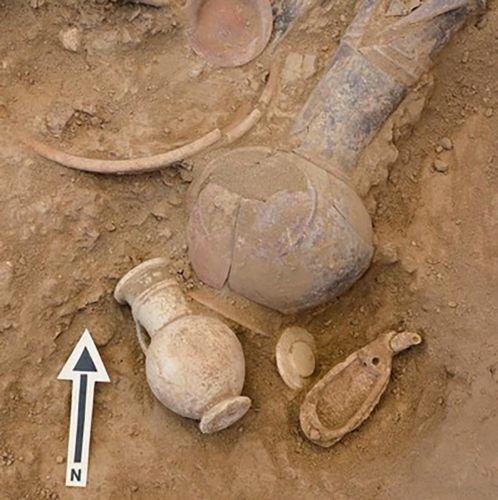Findings dating from the end of the 15th and 14th centuries BC, provide evidence of the existence of a prosperous Cypriot society in the area of Dromoloxia-Vyzakia, near the Hala Sultan Mosque, that had established relations with civilisations throughout the Mediterranean and beyond, according to the Department of Antiquities, that announced on Friday the end of the May-June 2022 excavation season, in the area in question.
The excavations in the Late Bronze Age port city are being carried out by a team from the University of Gothenburg in Sweden, led by Professor Peter M. Fischer.
This Late Bronze Age city, it is added, which flourished between 1630 and 1150 BC, is located on the coast of the Larnaca Salt Lake, near the Hala Sultan Mosque, a short distance from the Larnaka International Airport.
Findings, the press release says, “testify to the existence of a rich Cypriot society, which had established relations with cultures throughout the Mediterranean and beyond.” The wealth of the inhabitants in the settlement at Dromolaxia-Vyzakia was based on the production and export of copper and long-distance trade. “This is evidenced by the tons of slag of copper and ore, which were processed in laboratories within the settlement,” the press release adds.
The excavations, according to the Department of Antiquities, focused on the city cemetery where two tombs had been identified and that contained material from the end of the 15th and the 14th centuries BC, which correspond to the Late Cypriot IIA-B period, the Late Helladic IIIA1-2 period and the famous 18th Dynasty of Egypt, it is added.
The two, “apparently family tombs” with a large number of people buried in each, were carved into the ground, while it is believed they belonged to wealthy families, judging by the type of finds, the Department of Antiquities says, adding that infants, young, and elderly persons were associated with a large number of burial artefacts. It is pointed out that, by “elderly”, it is meant people who rarely lived over 40, as life expectancy was low at this time.
The study of anthropological remains has not yet been completed, therefore, the calculation of the number of people, their sex and age of death needs further investigation, the press release says.
Regarding the findings, it is mentioned that ceramics is the main category of the artefacts discovered, mainly high-quality clay pots that were made in Cyprus, but also many imports. The most common imports came from the Mycenaean and Minoan world, while there are also imports from Anatolia, Syria-Palestine and Egypt.
It is worth noting, it is added, that one of the alabaster vessels from Egypt imitates Cypriot ceramics while some of the scarabs found have hieroglyphic inscriptions on them, which will be read soon.
It is added that there are also many ivory objects, which were handed over immediately after their discovery to the conservators of the Department of Antiquities to preserve this extremely fragile material.
In parallel with the excavations, a second team of the Swedish delegation, led by Dr. Teresa Bürge, studied the findings from previous excavations, which are kept in the warehouses of the Archaeological Museum of Larnaca. Professors Kirsi Lorentz and Sorin Hermon, and doctoral students at the Cyprus Institute, contributed to the work of the Swedish delegation. The Department of Antiquities says that the team of the Cyprus Institute offered its experience in the excavation and recording of anthropological remains and prepared two-dimensional and three-dimensional representations of ob

